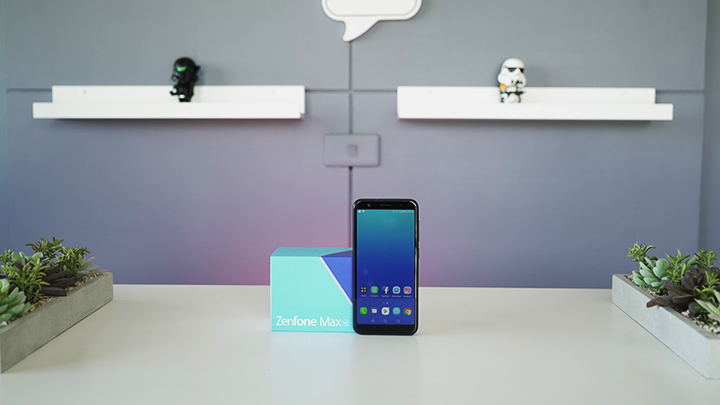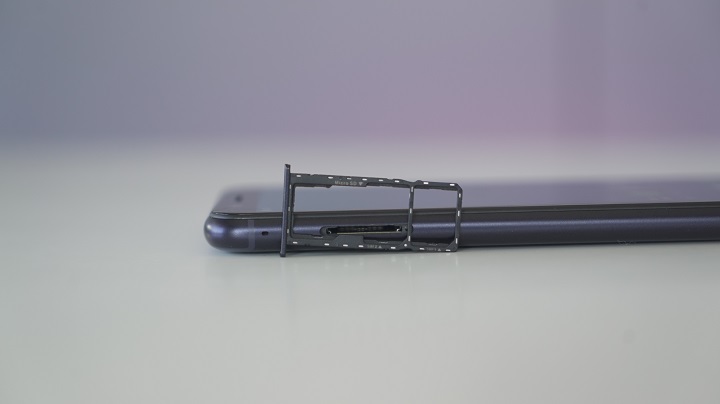During the official launch of the Zenfone 5 series in MWC, ASUS sneakily launched another device — The Zenfone Max M1. The new Max device can be considered as a toned-downed version of the brand’s first ever 18:9 device, The Zenfone Max Plus M1. Is it a device worth considering in a segment filled with strong contenders? Let’s find out in our full review!

Before all that though, check out our unboxing and hands-on video of the device.
Table of Contents

Being a sibling to the Max Plus M1, the Max M1 retains much of the same design structure. The phone is encased in a unibody chassis with little to no intricate designs or linings. It has that generic smartphone looks, but it’s simple and clean. The device is a little thicker than most due to its larger battery, though it’s still relatively thin and light.

Up front, we’ll be greeted by the 5.5-inch 18:9 HD+ display, 13MP front camera, front LED flash, speakerphone, and some sensors. The top and bottom bezels are quite thick, adding to the impression that this is one bulky device.

Over at the right side, we have the power/lock button and volume rockers

Then at the left is the slot for the dual-SIM + dedicated microSD card tray. It’s always nice seeing a non-hybrid setup.

Up top, is a lone 3.5mm audio port.

Down below, are the microUSB port and two speaker grilles containing the loudspeaker (right) and main microphone (left).

Flipping the device reveals the dual 13MP + 8MP rear cameras along with an LED flash, fingerprint scanner, and ASUS’ logo.
The Zenfone Max M1 feels solid and sturdy in the hands, thanks to its weight and overall thickness. The smooth black finish though makes the device quite slippery and is also a fingerprint magnet. Thankfully, ASUS included a silicon case in the package to provide a better grip and protection from fingerprint smudges.

The Zenfone Max M1 is equipped with a 5.5-inch 18:9 IPS display with a resolution of 1440 x 720. The screen itself has nice and sharp colors and icons are clear and crisp. Viewing angles are also good, thanks to the IPS panel. Sadly, the HD+ display may not be to everyone’s liking, especially for those who are accustomed to higher resolutions. Either way, the size and quality of the display are enough for an enjoyable viewing experience. Not to mention, it has enough brightness for outdoor use.

Audio-wise, we get a pretty average loudspeaker. The Mids and Highs are there and it can get pretty loud, although we do lose a bit of clarity at max volumes. As with most phones, Lows are non-existent. Thankfully, we have ASUS’ Audio Wizard on board, which is a pretty awesome audio tuning software when paired with earphones.

ASUS gave the Zenfone Max M1 a different set of cameras from what we got with the Max Plus. For the rear duo, we got a 13MP f/2.0 aperture main and an 8MP 120-degree wide-angle secondary. For the front, we got a bumped up 13MP camera along with an LED flash. While the Max Plus M1 enjoyed quite a bit customization options, the same cannot be said for the Max M1. The rear cameras only have Panorama, Portrait, Wide-aperture, Beauty, Time Lapse, a set of filters and Auto while the front is only limited to Auto, Beauty and a set of filters. We even lost a Pro or manual mode, which would’ve helped a lot in terms of shot adjustment.

Rear camera shots are a mixed bag, some shots can be good though most of the time they’ll only be average at best. You will be able to take good pictures at certain conditions with a bit of tinkering on the focus point and the lighting angle. Which can be a pain and would’ve easily been remedied by a Pro or manual mode. It also doesn’t help that any direct light source will overexpose and overblow the image. Quick shots are only decent at best as auto-focus is a bit slow and the quality is just generally sub-par. Well-taken shots have good color reproduction, accuracy, and sharpness while quicker ones tend to have washed out colors and poor sharpness.
Wide-angle shots aren’t that great and have noticeable noise and grain. Low-light shots are actually okay with little noticeable noise and grain, though quality will take a big hit if the LED flash is used, which is kind of counterintuitive. Check out our sample photos.
Selfies are on the same page. You can get good ones in the right condition. Sadly, like the rear, any direct light source will overexpose and overblow the shot. We also lost the Selfie Master app, though beauty customizations are still quite extensive with four different toggles — Soften skin, Brighten Skin, Enhance Eyes, and Thin Cheeks. Shots won’t look overly artificial at lower levels, though once you put the toggles at around 7 and up, you will look like a Barbie doll. Low-light selfies are not that great though thankfully we have a softlight front LED flash for assistance. Check out our sample selfies.
Video recording maxes out at 1080p, 30fps. Autofocus is a bit jittery but quality is just about right. You get average color reproduction, accuracy, and sharpness. Audio could be better but is acceptable. Check out our sample video below.

Running the show for the Zenfone Max M1 is ASUS’ own ZenUI 5.0 based on Android 8.0 Oreo. Pre-installed apps only include Facebook, Messenger, and Instagram. Pair those with Google’s own apps, a few homebrews, and the system files and users will be left with 22.7GB from the initial 32GB.

It has a few distinct features like One hand operation, Multi-window, Easy mode, Kids mode, ZenUI safeguard, smart gestures via ZenMotion, and a few more under the advanced settings menu. The UI is actually really clean and has its own app drawer which users can easily access by swiping upward. The notifications tab, accessed by swiping downward, offers a wide variety of shortcut toggles. Multitasking and accessing split-screen multitasking is easily accessible when opening the recent apps (right on-screen button).

ASUS also equipped the Max M1 with the same facial recognition introduced in the Max Plus M1. While setup was easier and faster, unlocking was still quite the hassle. Even in sufficiently lit rooms, facial recognition fails most of the time and wearing accessories, like glasses, also proves to be problematic.
Powering the device is Qualcomm’s Snapdragon 430 chipset paired with Adreno’s 505 GPU and 3GB of RAM. Mundane tasks such as browsing, social media consumption, and phone navigation are a breeze. Multitasking is not a problem either thanks to the 3GB RAM. Light to moderate games like Mobile Legends, Rules of Survival, Zombie Tsunami, and Vain Glory are playable with minimal frame drops. Heavier games though, like Iron Blade: Monster Hunter RPG, Asphalt 8 Airborne, and PUBG Mobile will suffer from occasional frame drops, though still playable with acceptable frame rates. Check out the benchmarks below.

The Zenfone Max M1 has basic connectivity covered as it has WiFi, Bluetooth 4.0, GPS, and OTG. Call quality and signal reception are good, as long as you are in a serviceable area. GPS is also accurate and we had no problems with apps like Waze or Grab.

Being a sibling to the Max Plus M1, the Max M1 carries a hefty 4,000mAh battery, a mere 130mAh lower than the aforementioned device. The phone lasts about a day when doing light to moderate tasks and about half a day during heavy use, which includes multitasking and gaming. During our standard video loop test (Playing a 1080p video in Airplane mode at 50% brightness and 50% volume with earphones plugged in) the device lasted 11 Hours and 3 minutes, which is kind of bad considering the battery capacity. For a phone belonging to the supposed “battery king” series, it certainly has quite a short battery life. Charging from 0-100% takes about two to two and a half hours, which is acceptable for its capacity.
*PC Mark Battery test kept crashing during our test.

The Zenfone Max M1 is yet another device that seems to fall short in delivering on its promises. The phone could’ve easily been a strong contender in the budget segment if not for its disappointing battery. Thankfully, it has some redeeming qualities such as a respectable screen, a good performance, and an acceptable set of cameras. Add that to the fact that even though it is supposed to be a toned-down version of the Max Plus M1, it has better overall performance.
At Php8,995USD 153INR 12,994EUR 146CNY 1,116, the device sits at a dangerous price point. It is sandwiched between a few notable devices from competitors at lower and higher price points that can provide either better performance or better battery life at a more affordable price tag.
ASUS ZenFone Max M1 (ZB555KL) specs:
5.5-inch HD+ IPS display @ 1440 x 720px
2.5D glass
Qualcomm Snapdragon 430 CPU
Adreno 505 GPU
3GB RAM
32GB internal storage
expandable up to 256GB via microSD (dedicated slot)
Dual 13MP f/2.0 aperture + 8MP 120-degree wide-angle rear cameras w/ LED flash
13MP front camera w/ softlight LED flash
4G LTE
Dual SIM (Dual standby)
microUSB
WiFi
Bluetooth 4.0
GPS, A-GPS, GLONASS, BDS
Fingerprint scanner
ASUS ZenUI 5.0 (Android 8.0 Oreo)
4,000mAh battery
Colors: Deepsea Black, Sunlight Gold, Ruby Red
What we liked:
What we didn’t like:

YugaTech.com is the largest and longest-running technology site in the Philippines. Originally established in October 2002, the site was transformed into a full-fledged technology platform in 2005.
How to transfer, withdraw money from PayPal to GCash
Prices of Starlink satellite in the Philippines
Install Google GBox to Huawei smartphones
Pag-IBIG MP2 online application
How to check PhilHealth contributions online
How to find your SIM card serial number
Globe, PLDT, Converge, Sky: Unli fiber internet plans compared
10 biggest games in the Google Play Store
LTO periodic medical exam for 10-year licenses
Netflix codes to unlock hidden TV shows, movies
Apple, Asus, Cherry Mobile, Huawei, LG, Nokia, Oppo, Samsung, Sony, Vivo, Xiaomi, Lenovo, Infinix Mobile, Pocophone, Honor, iPhone, OnePlus, Tecno, Realme, HTC, Gionee, Kata, IQ00, Redmi, Razer, CloudFone, Motorola, Panasonic, TCL, Wiko
Best Android smartphones between PHP 20,000 - 25,000
Smartphones under PHP 10,000 in the Philippines
Smartphones under PHP 12K Philippines
Best smartphones for kids under PHP 7,000
Smartphones under PHP 15,000 in the Philippines
Best Android smartphones between PHP 15,000 - 20,000
Smartphones under PHP 20,000 in the Philippines
Most affordable 5G phones in the Philippines under PHP 20K
5G smartphones in the Philippines under PHP 16K
Smartphone pricelist Philippines 2024
Smartphone pricelist Philippines 2023
Smartphone pricelist Philippines 2022
Smartphone pricelist Philippines 2021
Smartphone pricelist Philippines 2020
jeybi says:
Please help me im so confused what is this model the price is the same as the Asus zenfone max Pro ZB601KL which is confusing because The pro version is better and also i dont see this in other global phone website one ph websites im so confused right now
Stick to one says:
waiting for max pro m1. :)
Jeff says:
Does zenfone max m1 has OTG support?
Jack says:
Ok po ba aya pang gaming? Hindi po ma lag?
ALICE says:
Then is there another android phone you can suggest for 8k? Because Im planning to buy a phone but Im confused on what to buy
Alduen says:
May problema ako sa zenfone max m1 ko. Ayaw nang maclick or napindot yun top part ng screen. Anong pwede kong gawin?
Saucey says:
Good evening. I disagree on the way how you did the battery testing. Why do it while airplane mode is on? Shouldn’t a cellphone battery test also include the turning on signal of the phone? Because in real usage, everyone needs and uses the cellphone signal. Because what makes a phone is the cell signal, be it 2g, 3g or 4g. Otherwise, all you’re testing is just a mere play toy with a big screen and wifi access. Furthermore, what’s the point of having the volume at 50% when you’re just plugging in the earphones? It renders the speakers useless. You’re better off muting the phone. Please do improve on your battery testing next time.
angie says:
i have a problem on my zenfone max m1 about the fingerprint sensor sometimes its working sometimes not.what will i do?
Benedict Guerrero says:
Sir, I want a Bluetooth 5.0 and I’m going to buy ASUS X00TDB and my search results lead me to this, you say it is Bluetooth 4? Where did you get that?